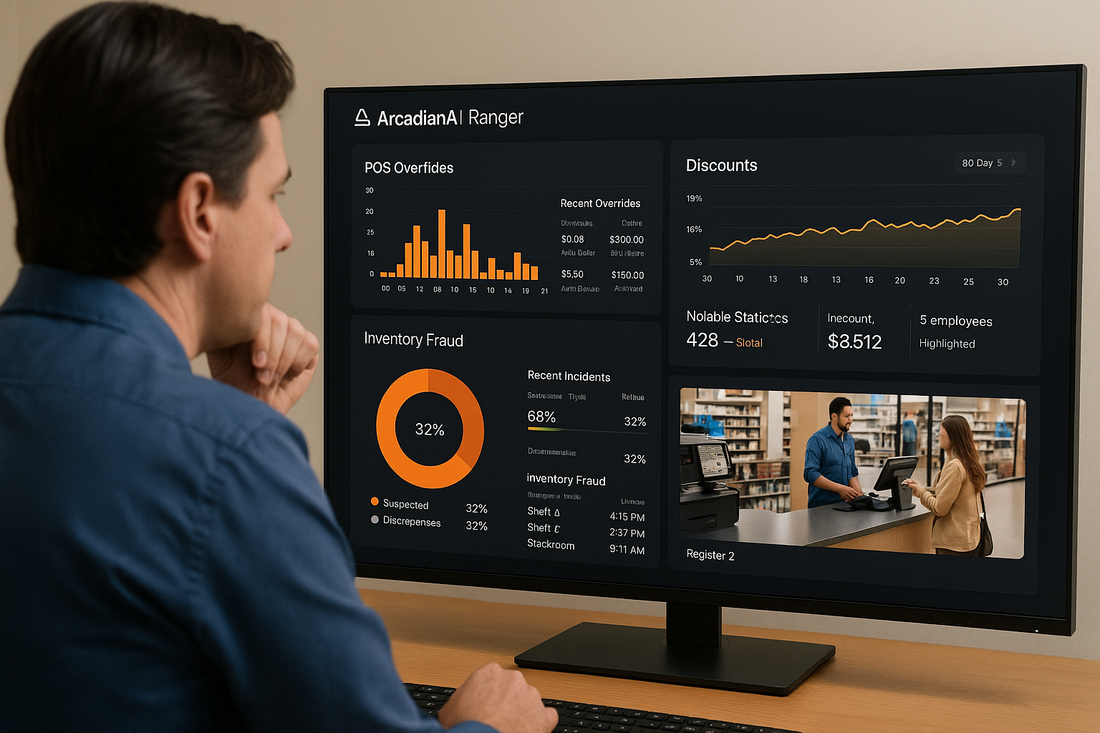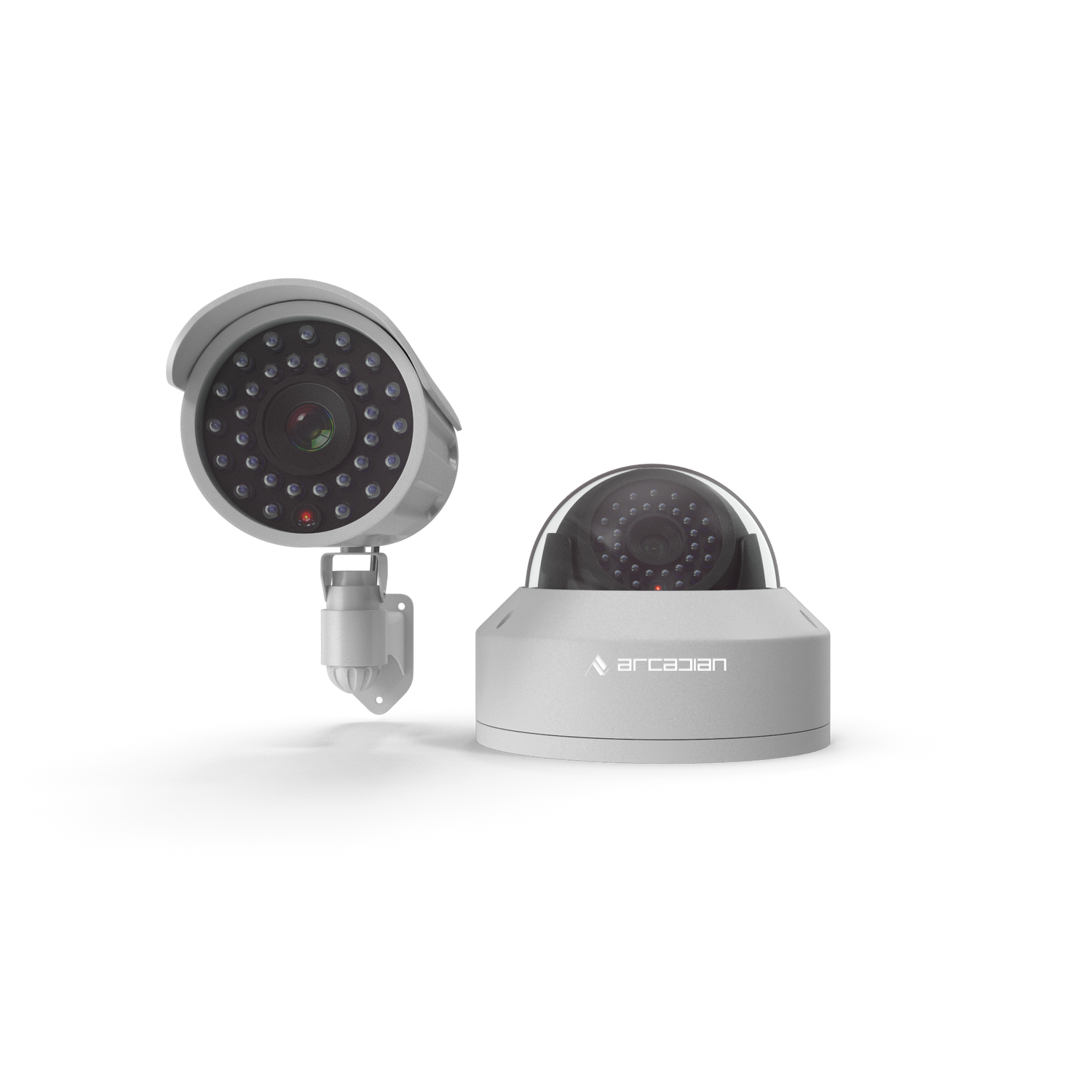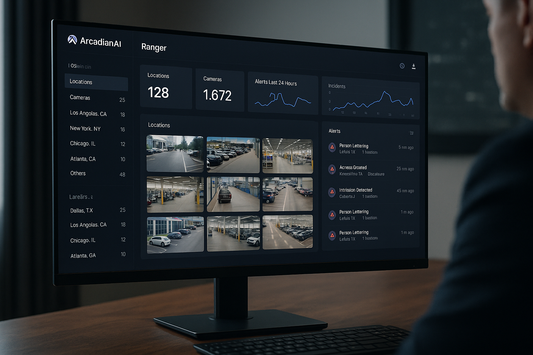Tackling Retail Fraud and Theft in 2025: The Top 5 Strategies Every Retailer Is Using (And Why AI Will Define the Future)
From POS overrides to dummy devices, retailers are trying everything to combat theft and fraud. But with crime rising, AI-driven tools like ArcadianAI’s Ranger are now the missing piece in protecting profits.

Introduction
Retail crime has never been more sophisticated — or more costly. According to the National Retail Federation, U.S. retailers lost nearly $121 billion to shrink in 2024, a staggering increase driven by organized retail crime (ORC), return fraud, and employee theft. ArcadianAI works daily with retailers across North America to address these challenges, and the trends are clear: while legacy security providers like Verkada, Genetec, Eagle Eye Networks, and Rhombus focus on cameras alone, retailers are demanding intelligent, adaptive fraud prevention that looks beyond static video feeds.
A recent industry survey asked retailers, “How are you tackling internal and/or external fraud or theft in your stores?” The top five responses reveal a mix of traditional tactics and evolving strategies — but also highlight where manual methods fall short without AI support.
Quick Summary / Key Takeaways
-
POS overrides remain a major fraud risk.
-
Dummy devices deter theft but frustrate shoppers.
-
Auditing is common but reactive.
-
Surprise inventory checks catch issues — but not in real time.
-
Commission audits reduce abuse but miss collusion.
-
ArcadianAI Ranger adds adaptive AI to close every gap.
Background & Relevance
Why now? Retail crime is rising across the U.S. and Canada. A 2025 Retail Council of Canada report found 82% of retailers expect shrink to rise this year, while Walmart, Target, and CVS have publicly acknowledged store closures due to theft. Organized retail crime groups now use encrypted communications and resale networks to scale their operations. Without adaptive AI, retailers are stuck fighting modern threats with yesterday’s tools.
Core Topic Exploration
1. POS Manager Overrides for Discounts
At 47% adoption, manager overrides are the top tactic. While necessary for customer satisfaction, overrides are one of the most exploited fraud vectors in retail. Employees may collude with friends, use discounts for personal purchases, or hide theft under legitimate-looking transactions.
Competitor shortfall: Traditional POS monitoring tools flag only “large” or “frequent” overrides, missing contextual fraud patterns.
ArcadianAI Advantage: Ranger integrates video, transaction logs, and behavioral AI to detect patterns like repeat offenders, suspicious timing (e.g., after closing), or overrides tied to specific high-risk employees. Instead of a quarterly audit, fraud is flagged in real time.
2. Limiting Products In-Store / Using Dummy Devices
45% of retailers now limit inventory or use dummy display units, especially in electronics. Apple, Best Buy, and Verizon stores regularly display non-functional devices to deter grab-and-run theft.
The trade-off? Customers can’t fully experience the product. Sales conversion drops, and employee frustration rises.
ArcadianAI Solution: Rather than punishing customers with limited demos, Ranger monitors shopper-device interactions, detecting tampering, loitering, and theft attempts without removing the authentic experience.
3. Regularly Auditing Discounts Given
42% of retailers rely on manual discount audits. While necessary, they are reactive and labor-intensive, often weeks behind real incidents.
ArcadianAI Upgrade: Ranger transforms this process from “after the fact” to real-time anomaly detection, linking camera footage to discount transactions. A suspicious $300 override at POS instantly alerts loss prevention managers with video context — no spreadsheets required.
4. Surprise Inventory Audits and Blind Counts
41% of respondents conduct surprise or blind inventory counts. While effective at catching errors, these consume significant labor hours and disrupt operations.
ArcadianAI Difference: Ranger leverages computer vision to automate live inventory validation. Instead of sending employees to count in the back room, the AI flags discrepancies between expected stock levels and observed shelf activity — eliminating the surprise element while boosting accuracy.
5. Auditing Commission Reports
36% of retailers track commissions to prevent inflated or fraudulent reporting. High earners may manipulate systems, push fake sales, or collude with coworkers.
ArcadianAI Fix: By merging video with transaction logs, Ranger verifies sales authenticity. Did the employee actually sell that high-ticket handbag, or did they “sell” it to an accomplice walking out the door? AI makes the invisible visible.
Comparisons & Use Cases
How ArcadianAI Outperforms Traditional Approaches
| Fraud Tactic | Legacy Approach | Limitation | ArcadianAI Ranger Advantage |
|---|---|---|---|
| POS Overrides | Manual audits | Weeks behind | Real-time AI alerts with video |
| Dummy Devices | Non-functional demos | Hurts sales | Monitors real products safely |
| Discount Audits | Quarterly reviews | Reactive | Instant anomaly detection |
| Inventory Counts | Surprise audits | Labor cost | Automated AI vision counts |
| Commission Reports | Manual analysis | Easy to game | Video-verified transactions |
Real-World Example:
-
Target: Reported millions lost to “sweethearting” (employees giving unauthorized discounts to friends).
-
Nordstrom: Uses RFID but still struggles with shrink in apparel.
-
Canadian Tire: Tested surprise audits but admitted labor costs outweighed benefits.
ArcadianAI enables these same retailers to cut shrink by up to 40% in pilot deployments while also reducing labor overhead.
Common Questions (FAQ)
Q1: Can AI really detect fraud at the POS in real time?
Yes. By linking transaction logs with live video, AI can flag suspicious overrides or refunds instantly.
Q2: Won’t AI surveillance create privacy issues?
ArcadianAI follows GDPR, CCPA, and NDAA compliance standards with secure, anonymized analytics.
Q3: How does this differ from regular video analytics?
Traditional analytics track motion; Ranger uses adaptive AI that understands context, such as repeat fraud patterns or collusion.
Q4: Can AI reduce false alarms?
Yes. Ranger’s adaptive intelligence reduces false alerts by up to 85% compared to legacy VMS systems.
Q5: Is this scalable across multiple store locations?
Absolutely. ArcadianAI’s cloud-native platform allows centralized oversight of thousands of stores with location-level insights.
Conclusion & CTA
Retailers have tried audits, dummy devices, and manual oversight — but fraud continues to rise. The top 5 tactics from 2025 reveal an industry struggling with reactive measures.
ArcadianAI’s Ranger changes the game by adding adaptive AI, real-time fraud detection, and centralized visibility across all locations. Instead of chasing fraud weeks later, retailers finally gain the power to stop it as it happens.
👉 See ArcadianAI in Action → Get Demo – ArcadianAI
Security Glossary (2025 Edition)
Adaptive AI — AI that evolves its models dynamically to respond to changing fraud and theft patterns.
Blind Inventory Count — An audit method where staff count stock without prior knowledge of expected numbers.
Commission Fraud — Manipulation of sales reporting or collusion to inflate employee earnings.
Dummy Device — Non-functional display item used to deter theft in retail.
NDAA Compliance — U.S. law banning certain foreign-manufactured surveillance tech in critical industries.
ORC (Organized Retail Crime) — Coordinated theft by professional groups for resale.
POS (Point of Sale) — Retail system where transactions are processed.
POS Override — Manual manager-approved discount or refund, often exploited for fraud.
Shrink — Loss of inventory due to theft, fraud, or errors.
Sweethearting — Employee fraud where unauthorized discounts are given to friends/family.
Surprise Audit — Unscheduled inventory check designed to catch fraud or errors.
Transaction Log — Record of POS activity, used for auditing and fraud detection.
VMS (Video Management System) — Traditional software for managing CCTV footage, less intelligent than adaptive AI.
VSaaS (Video Surveillance as a Service) — Cloud-based video storage and monitoring service.

Security is like insurance—until you need it, you don’t think about it.
But when something goes wrong? Break-ins, theft, liability claims—suddenly, it’s all you think about.
ArcadianAI upgrades your security to the AI era—no new hardware, no sky-high costs, just smart protection that works.
→ Stop security incidents before they happen
→ Cut security costs without cutting corners
→ Run your business without the worry
Because the best security isn’t reactive—it’s proactive.







